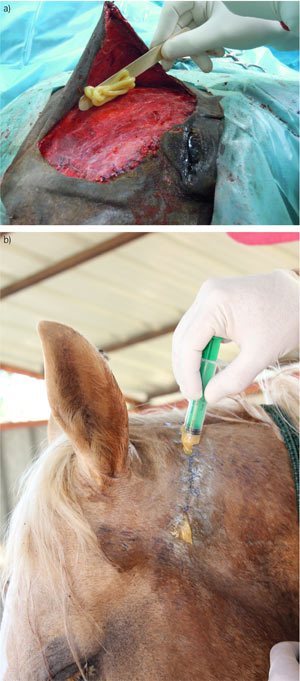

Researchers looking at wound healing in horses have found that applying medical-grade honey to the wound, as it is repaired, may help control infection and reduce wound breakdown.
Under ideal conditions, surgical repair may lead to rapid (“first intention”) healing. But wound breakdown is not uncommon, particularly in lower limb injuries. Factors such as infection and movement are significant problems.
Eleven veterinarians in Israel were involved – between them treating 127 lacerations. Most wounds (30%) were on the lower limb. Upper limb wounds accounted for 28% and head wounds a further 24%.
Wounds were repaired using a standardised protocol, with some being chosen at random to have medical-grade honey (MGH) applied to the wound. (Medical grade honey has been sterilised by gamma radiation to eradicate any bacterial spores – such as Bacillus spp and Clostridium spp – that may be found in raw honey.)
In all, 69 wounds received an application of MGH; 58 did not.
The study’s authors, from Israel’s Koret School of Veterinary Medicine, at the Hebrew University of Jerusalem, report that compared to control horses, those treated with MGH were more likely to heal completely and to have no signs of infection. No adverse effects of the MGH were reported.
Writing in the Equine Veterinary Journal, they concluded that intralesional application of MGH to lacerations before closure may help prevent infection and wound breakdown.
They pointed out that their study was a non-blinded clinical trial relying on subjective assessments of wound healing and as such was open to bias. They suggest that larger, blinded studies focusing on wounds at a specific location with more objective assessment should be pursued.
A podcast is available on the study, featuring Gal Kelmer, an equine surgeon and head of the hospital at Veterinary Medicine at Jerusalem’s Hebrew University:
PGlmcmFtZSB0aXRsZT0iRVZKIEluIENvbnZlcnNhdGlvbiBQb2RjYXN0IE5vLiAzOC0gSnVuZSAyMDE5IiBzcmM9Imh0dHBzOi8vd3d3LnBvZGJlYW4uY29tL21lZGlhL3BsYXllci9za3M1ay1iMmE0YmQtcGI/ZnJvbT1zaGFyZSZza2luPTEmc2hhcmU9MSZmb250cz1IZWx2ZXRpY2EmZG93bmxvYWQ9MSZ2ZXJzaW9uPTEmdmpzPTEmc2tpbj0xIiBoZWlnaHQ9IjMxNSIgd2lkdGg9IjEwMCUiIHN0eWxlPSJib3JkZXI6IG5vbmU7IiBzY3JvbGxpbmc9Im5vIiBkYXRhLW5hbWU9InBiLWlmcmFtZS1wbGF5ZXIiPjwvaWZyYW1lPg==
STUDY: Intralesional application of medical grade honey improves healing of surgically treated lacerations in horses. H. Mandel, G. A. Sutton, E. Abu, G. Kelmer. Equine Veterinary Journal 2019. https://doi.org/10.1111/evj.13111